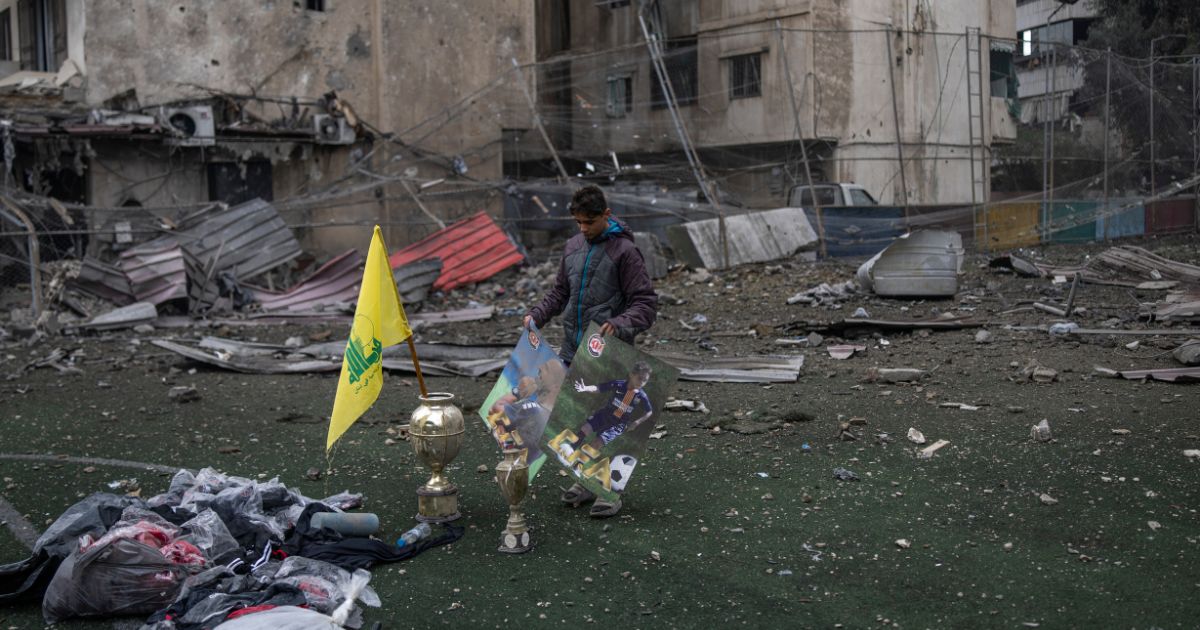A young man salvages equipment and posters from a soccer field damaged by an airstrike as a Hezbollah flag sits in a trophy in Beirut, on Wednesday, Nov. 27, 2024. Thousands of people displaced by a year of fighting between Israel and Hezbollah packed roads leading to southern Lebanon on Wednesday as a U.S.-backed cease-fire began to take hold, bringing hope for an end to the deadliest war between the two sides in decades. (Diego Ibarra Sánchez/The New York Times)

- As a ceasefire takes effect, the Lebanese army strengthens its presence in the south, coordinated with UN peacekeepers.
- Thousands are heading back to southern Lebanon, despite Israeli curfews and warnings against immediate return to some areas.
- The ceasefire, mediated by the U.S. and France, faces skepticism, as Israel continues to target Hezbollah strongholds and fighting persists in Gaza.
Share
|
Getting your Trinity Audio player ready...
|
The Lebanese army said it was sending more forces to southern Lebanon on Wednesday as a U.S.-backed cease-fire began to take effect between Israel and Hezbollah, and as thousands of displaced Lebanese began to return to areas ruined by Israeli strikes.
Bumper-to-bumper traffic jammed roads leading out of Beirut, the capital, as people sought to make their way back to southern towns and villages devastated by the war, the deadliest between Israel and Hezbollah in decades. Suitcases, mattresses and blankets were stacked on the roofs of cars moving south, even as Israel’s military warned civilians against immediately returning to some areas and declared a curfew over much of southern Lebanon until Thursday morning.
Related Story: Trump Team Says Israel-Hezbollah Ceasefire Deal Brokered by Biden Is Actually ...
Under the agreement, which was mediated by the United States and France, Israel will withdraw its forces from Lebanon over the next 60 days; Hezbollah will move its fighters north of the Litani River, which runs roughly parallel to the Israel-Lebanon border; and the Lebanese army will send more troops to the country’s south.
Lebanese Convoys Seen in South Lebanon
Lebanese military convoys were seen on roads in southern Lebanon early Wednesday. The country’s armed forces said in a statement that the army was “reinforcing its deployment in the sector south of the Litani and extending the state’s authority in coordination with the United Nations Interim Force in Lebanon,” or UNIFIL, an international peacekeeping force.
But many questions remained about the durability of the truce, which was underscored when Israel’s military shelled two villages in southern Lebanon, Khiam and Kfar Kila. Asked about the shelling, the military said in a statement that its soldiers had opened fire after identifying a vehicle in “a zone prohibited for movement” in Lebanon, forcing it to turn around. It was not immediately clear where that took place.
The fighting since last October displaced more than 1 million people. It intensified in recent months as Israel killed Hezbollah’s longtime leaders, wiped out much of its weapons stockpiles and invaded southern Lebanon. Israel’s military continued its intense bombardment of areas it called Hezbollah strongholds until the last hour before the ceasefire took effect.
Hezbollah has long wielded considerable power in Lebanon, both as a political party with representation in parliament and ministers in the government and as a military force that is not under the state’s control.
Related Story: Israel Approves Proposed Ceasefire With Lebanon’s Hezbollah
What Else to Know?
- Biden’s Gaza push: President Joe Biden said on social media that the United States would “make another push” in the coming days for a ceasefire in the Gaza Strip, where a truce between Israel and the militant group Hamas has proved much harder to reach. He said the ceasefire with Hezbollah “brings us closer to realizing a future I’ve been pushing for my entire presidency where the Middle East is at peace, prosperous, and integrated across borders.”
- Israel’s aims: Prime Minister Benjamin Netanyahu endorsed the deal Tuesday night and argued that a truce would allow Israel to rebuild its weapons stockpiles while it works to isolate Hamas. He also said it would allow Israel to focus on the threat posed by its regional adversary, Iran.
- Displaced Israelis: The ceasefire agreement drew mixed emotions from some of the tens of thousands of displaced residents of northern Israel who have been moving between hotels, rentals and friends’ and relatives’ homes for more than a year. Some hailed the truce as a chance to return home, while others worried that Hezbollah would be able to rearm and again threaten their communities.
- Despair in Gaza: A lasting ceasefire has proved harder to reach in Gaza because the hostages held by Hamas give it more leverage in negotiations, and because any deal with the group could threaten Netanyahu’s governing coalition. That leaves Gaza residents heading into a second winter of war with little hope of an end to Israel’s military campaign there.
- Netanyahu’s arrest warrant: France’s foreign ministry strongly suggested Wednesday that Netanyahu would not immediately be arrested if he came to French territory, despite an International Criminal Court arrest warrant accusing him of war crimes and crimes against humanity in Israel’s war in Gaza.
—
This article originally appeared in The New York Times.
By Euan Ward, Ben Hubbard and Aaron Boxerman/Diego Ibarra Sánchez
c. 2024 The New York Times Company



















